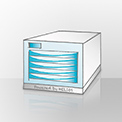Sun Solaris 10 ZFS offers blazing filesystem performance
Sample ZFS performance
|
Task |
ZFS [min.] |
UFS [min.] |
|
|
Create |
3.75 |
93.75 |
25x faster |
|
Rebuild HELIOS Desktop |
25.30 |
116.75 |
4.6x faster |
|
Remove |
16.75 |
217.30 |
13x faster |
ZFS feature overview
- 128-bit file system(s); no practical size limit
- Transactional semantics (like journaling, disk is always consistent)
-
Dynamic storage management
- Allows growing file system size
- Allows adding disks
- Allows striping and mirroring
- No dedicated file system space reservation required, e.g. two file systems can grow until ZFS pool is full
-
File system snapshot support
- Allows backup of the frozen system without service interrupt
- Allows backup snapshots to allow easy access of older files, e.g. snapshot at 10 a.m., 12 a.m., 2 p.m., 4 p.m., etc.
- Allows replicating a ZFS snapshot (e.g. to a remote disk / server)
- Allows rolling back the file system to an older snapshot version
- Snapshot cloning allows read-write access of a snapshot
- Disk block checksums will detect data errors
- Disk block compression features
- ZFS disk image compatibility between different platforms (SPARC / AMD)
ZFS requirements
- Sun SPARC / x86 (64-bit is highly recommended!)
- Solaris 10 (edition 11/06) or newer; earlier Solaris 10 ZFS versions will not work reliably
- 512 MB RAM (the more memory the better performance!)
- Any disk or RAID system will work
- HELIOS UB products (arch.: “sol4” and “solx86”)
- Attention: For using ZFS with database applications see TechInfo #106
What is the performance advantage of running HELIOS file services on ZFS?
ZFS “HOWTO” HELIOS samples
-
Create a ZFS pool via:
Format: zpool create poolname storage*
zpool create testpool c0t3d0
* storage can be diskname (c0t3d0), partitionname(c0td0s5), or filepath(/data/bigfile) -
Create two file systems “project1” and “project2” on this pool
Format: zfs create poolname / filesystemname
First create a file system hierarchy, which acts as a container for the individual file systems that will be created later, and set required properties:
# zfs create testpool/myprojects
# zfs set mountpoint=/export/myprojects testpool/myprojects
Then create your individual project file system(s):
# zfs create testpool/myprojects/project1
# zfs create testpool/myprojects/project2
Both file systems “project1” and “project2” will automatically be mounted below “/export/myprojects”.
Note: Where to define HELIOS volumes: at least one level below file system mount point!
Example: For the “/export/myprojects/project1” file system the HELIOS mount point could be at “/export/myprojects/project1/project1_volume” but must NOT reside on the “project1” directory itself. This is required due to the way ZFS stores its snapshot information from a ZFS file system.
Additional storage can be added via:
Format: zpool add poolname storage
Add a second disk “c0t4d0”:
# zpool add testpool c0t4d0 -
Create a snapshot of the file system “project”:
Format: zfs snapshot <poolname>/<filesystemname>@snapshotname
# zfs snapshot testpool/myprojects/project1@snap -
Create a clone read-write file system of the snapshot:
Format: zfs clone <poolname>/<filesystemname>@snapshotname <poolname>/<filesystemname>
# zfs clone testpool/myprojects/project1@snap testpool/myprojects/clone_p1
The clone of “project1” is available at: “/export/myprojects/clone_p1”. -
List all ZFS file systems:
# zfs list
NAMEUSEDAVAILREFERMOUNTPOINTtest/…/project129.2M53.8G28.7M/exp/…/project1test/…/project2329.2M53.8G328.8M/exp/…/project2 test/…/project1@snap 505K–28.7M–test/…/clone_p1806K53.8G28.7M/exp/…/clone_p1 -
Remove the clone, remove the snapshot:
Format: zfs destroy <poolname>/<filesystemname>
OR zfs destroy <poolname>/<filesystemname>@snapshotname
# zfs destroy testpool/myprojects/clone_p1
# zfs destroy testpool/myprojects/project1@snap -
Backup a ZFS file system snapshot into a disk file:
Format: zfs send <poolname>/<filesystemname>@<snapshotname> > filepath
# zfs send testpool/myprojects/project1@snap > /backup/project1_snap.bkp -
Remote HTTP based ZFS administration via:
“https://hostname:6789/zfs”
Get I/O statistics
# zpool iostat -v
|
CAPACITY |
OPERATION |
BANDWITH |
||||
|
POOL |
USED |
AVAIL |
READ |
WRITE |
READ |
WRITE |
testpool |
21.6G |
46.4G |
11 |
25 |
875K |
516K |
c0t3d0 |
21.6G |
46.4G |
11 |
25 |
875K |
516K |
fsstat <filesystem> you can list I/O statistics per file system.# fsstat /export/myprojects/project1 |
NEW |
NAME |
NAME |
ATTR |
ATTR |
LOOKUP |
RDDIR |
READ |
READ |
WRITE |
WRITE |
file |
remov |
chng |
get |
set |
ops |
ops |
ops |
bytes |
ops |
bytes |
19.2M |
12.3M |
43 |
123M |
14.0M |
436M |
2.63M |
28.0M |
12.1G |
16.8M |
15.6G |
Tested applications
HELIOS products
|
Highest-Performance Server for Mac Clients |
|
|
Highest-Performance Server for Windows Clients |
|
|
Highest-Performance Server for Real Time Remote File Access |
|
|
Server-based Image Processing and ICC Color Transformation |
|
|
Create PDF Server • PDF Preflight • PDF Printing • PDF OPI |
|
|
Local and Remote Proofing on Monitor and Printer |
Tools
|
Professional tool to test file server compatibility |
|
|
Professional tool to test and measure the performance of AppleShare services |
|
|
HELIOS “htar” |
UNIX batch disk backup utility |
|
HELIOS “dt” tools |
Allows storing and working with client files on a UNIX server, while ensuring that Mac resource information, Windows file stream information, and meta data are left intact |
|
HELIOS “mkisofs” |
– |
|
HELIOS “winfstest” |
– |
|
“dd” performance testing |
– |
Performance test details
Tested configuration:
- Sun Fire X4100 Server (two AMD CPUs, 4 GB RAM)
- Two 70 GB disks (one for the OS, second for ZFS)
- Solaris 10 (edition 11/06), all patches installed (as of January 15, 2007)
rebuild -f.rm -r.
Notes:
ZFS does not have user / group quotas, instead file system quotas. As it is very simple to set up a file system per user / project / etc (with quota and other properties as required), this could be a simple mechanism to use.
Additional ZFS links
ZFS documentation

 Enterprise Server
Enterprise Server
 Developers / SDK
Developers / SDK
 Retail / Industrial
Retail / Industrial
 Newspapers / Publishers
Newspapers / Publishers
 Photographer / Studios
Photographer / Studios
 Ad Agencies / Premedia / Printers
Ad Agencies / Premedia / Printers
 Video & Entertainment
Video & Entertainment
 Cloud Collaboration
Cloud Collaboration
 HD Color
HD Color
 Image Processing
Image Processing
 Proofing
Proofing
 WebShare Connectivity
WebShare Connectivity
 Workflow Automation
Workflow Automation
 File Server
File Server
 Press Releases
Press Releases  Videos
Videos  Newsletters
Newsletters  Events
Events